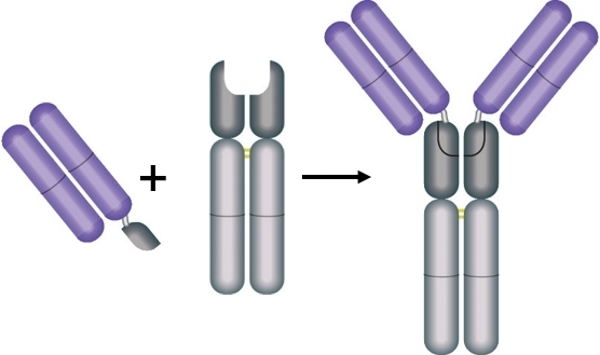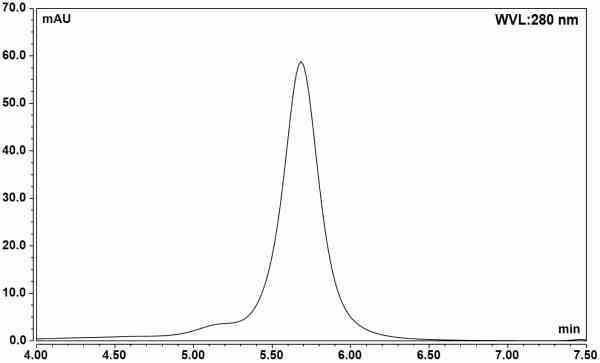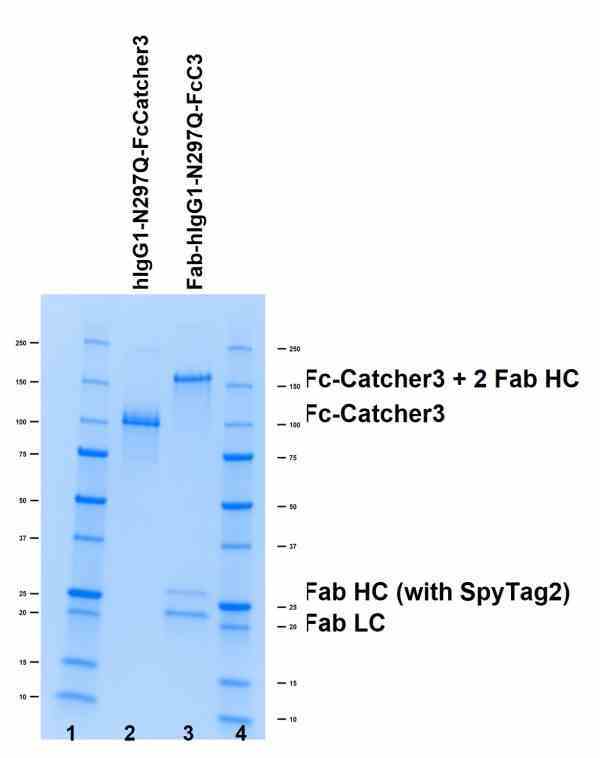Human IgG1-N297Q-FcSPYCATCHER3



Human IgG1-N297Q-FcSpyCatcher3
- Product Type
- Recombinant Protein
- Specificity
- Human IgG1-N297Q-FcSPYCATCHER3
| Human IgG1-N297Q-FcSpyCatcher3 (hIgG1-N297Q-FcSpyCatcher3) contains a SpyCatcher3 (Keeble et al. 2019) fused to the hinge region, CH2 and CH3 of human IgG1 (Hentrich et al. 2020), resulting in a 77.2 kDa protein. It incorporates a N297Q mutation within its Fc region (mutation of the asparagine residue at position 297 into a glutamine) which can prevent binding to FcR1. Each SpyCatcher3 subunit can form a stable covalent isopeptide bond with a second protein that includes a SpyTag. The reaction occurs spontaneously on mixing, is rapid, irreversible, high-yielding and shows good specificity. The reaction is robust at pH 5 to 8, at temperatures from +4°C to +37°C, in various buffer conditions (Ca2+/Mg2+ not needed) and in the presence of detergents. The reaction also occurs inside cells (in vivo). Since the speed of the coupling reaction is concentration dependent, it is recommended to use hIgG1-N297Q-FcCatcher3 undiluted. Human IgG1-N297Q-FcSpyCatcher3 is compatible with Bio-Rad's recombinant HuCAL antibodies with a SpyTag2 at the C-terminus of the heavy chain. Download FcSpyCatcher coupling protocol View all available Catchers |
- Target Species
- Protein/peptide tag
- Product Form
- FcSpyCatcher3 purified recombinant protein, fused to the hinge region, CH2, and CH3 of human IgG1 - liquid
- Preparation
- Recombinant protein expressed in mammalian cell line and purified by affinity chromatography
- Source
- HKB-11
- Buffer Solution
- Phosphate buffered saline
- Preservative Stabilisers
- 0.0095% MIT
- Purity
- ≥90% determined by SDS-PAGE under reducing conditions and visualized by coomassie blue staining
- Approx. Protein Concentrations
- 80 µM (6.2 mg/ml)
- Protein Molecular Weight
- Predicted 77212 Da
- Regulatory
- For research purposes only
- Guarantee
- 12 months from date of despatch
- Acknowledgements
- This product and/or its use is covered by claims of U.S. patents, and/or pending U.S. and non-U.S. patent applications owned by or under license to Bio-Rad Laboratories, Inc. See bio-rad.com/en-us/trademarks for details.
Storage in frost-free freezers is not recommended.
This product should be stored undiluted. Avoid repeated freezing and thawing as this may denature the protein. Should this product contain a precipitate we recommend microcentrifugation before use.
| Application Name | Verified | Min Dilution | Max Dilution |
|---|---|---|---|
| Immunoassay |
- Instructions For Use
- View FcSpyCatcher Coupling Protocol
| Description | Product Code | Applications | Pack Size | List Price | Your Price | Quantity | |
|---|---|---|---|---|---|---|---|
| SpyTag3 Peptide | BLP086 | IY | 1 mg |
|
Log in | ||
| List Price | Your Price | ||||||
|
|
Log in | ||||||
| Description | SpyTag3 Peptide | ||||||
| Recombinant Human IgG1 N297Q Kappa Allotype G1m3 | HCA394 | E | 0.1 mg |
|
Log in | ||
| List Price | Your Price | ||||||
|
|
Log in | ||||||
| Description | Recombinant Human IgG1 N297Q Kappa Allotype G1m3 | ||||||
| Human IgG1-FcSpyCatcher3 | TZC009 | IY | 1 mg | Log in | |||
| List Price | Your Price | ||||||
| Log in | |||||||
| Description | Human IgG1-FcSpyCatcher3 | ||||||
| Human IgG1-LALA-FcSpyCatcher3 | TZC027 | IY | 1 mg | Log in | |||
| List Price | Your Price | ||||||
| Log in | |||||||
| Description | Human IgG1-LALA-FcSpyCatcher3 | ||||||
Antibody Characterization Reference
-
Hentrich, C. et al. (2021) Periplasmic expression of SpyTagged antibody fragments enables rapid modular antibody assembly.
Cell Chem Biol. 28 (6): 813-824.e6. -
Zakeri, B. et al. (2012) Peptide tag forming a rapid covalent bond to a protein, through engineering a bacterial adhesin.
Proc Natl Acad Sci U S A. 109 (12): E690-7. -
Keeble, A.H. et al. (2019) Approaching infinite affinity through engineering of peptide-protein interaction.
Proc Natl Acad Sci U S A. 10: 116 (52): 26523-33.
- Licensed Use
- For in vitro research purposes. Any re-sale in any form or any other commercial application needs a written agreement with Bio-Rad.
TZC026
If you cannot find the batch/lot you are looking for please contact our technical support team for assistance.
Please Note: All Products are "FOR RESEARCH PURPOSES ONLY"
View all Anti-Protein/peptide tag ProductsAlways be the first to know.
When we launch new products and resources to help you achieve more in the lab.
Yes, sign me up

